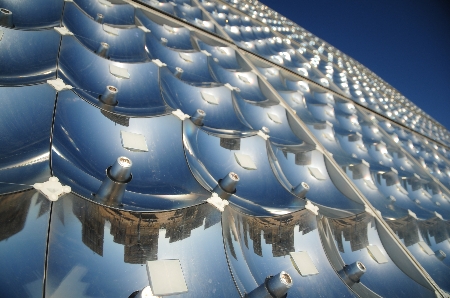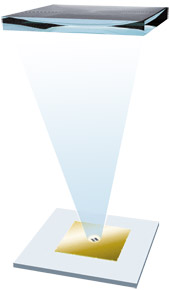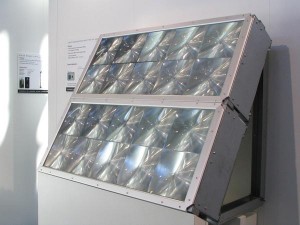A new CPV power station has just come online in Mildura, Australia. It generates 1.5 Megawatts providing enough electricity to power 500 homes. This is a pilot renewable energy project producing utility-scale solar power. Described as a Dense Array CPV, plans are underway to add 100 Megawatts of capacity with construction to begin in 2014.
Dense Array CPV is highly efficient in converting a wide range of the solar spectrum, from short wave to infrared, into electricity. It does using inexpensive concentrating optics which focus sunlight on a multi-junction solar cell only a few square millimeters in size. This allows the manufacturer, Soltec, to increase conversion rates to efficiencies as high as 41%.
Soltec’s Dense Array CPV is marketed under the brand name Concentrix. First pioneered by scientists and researchers in Germany at the Fraunhofer Institute beginning in the 1970s, the technology was spun off for commercialization in 2009. Concentrix uses a Fresnel lens (seen in the image below, and talked about in an earlier posting on this blog site) to focus sunlight through a layered-glass matrix. The glass is durable and low cost. It is also scratch resistant and provides a low thermal expansion coefficient to make it highly suitable for use in desert and semi-arid warm climates.
How does a CPV like Concentrix differ from conventional solar photovoltaic systems? A CPV uses a curved mirror and lens to concentrate sunlight. This means less less space to generate the same amount of energy output.
In areas of the planet where sunlight is abundant such as in semi-arid Australia this type of technology makes a lot of sense. It is demonstrably more than twice as efficient as any other solar technology out there. And when tracking mechanisms are added can follow the Sun throughout the day to ensure a high rate of output.
In addition to the Australian site Soltec has built a demonstration installation in Saudi Arabia and 6 other desert countries on the planet. Its technology has an expected life of 30 plus years and can withstand extreme desert conditions including sandstorms.
And Soltec isn’t alone in the race to built ever more efficient CPVs. Sharp, the Japanese company, recently announced a CPV (seen in the image below) capable of achieving conversion efficiencies of 44.4% which makes it the current world record holder in solar photovoltaics.
Meanwhile Soltec is going ahead in scaling up from its current pilot projects. It is building a 44 Megawatt CPV in the Western Cape, South Africa and has plans to increase photovoltaic installations in that country to 1,450 Megawatts by 2016.
Of course, all of this renewable energy still needs to address the two major problems associated with solar energy:
What happens when the sun is not shining?
How do you feed variable renewable energy generated hundreds of kilometers away from consumers into a power grid and maintain affordability?
One answer is to make the renewable energy source continuous. That means developing complimentary storage technology to generate continuous energy when the CPVs are not in operation.



















[…] hoffen nicht, denn insbesondere neue Entwicklungen im Bereich Photovoltaik wie die CPV-Technologie (Concentrated Photovoltaics) lassen Solarstrom endlich bezahlbar werden. Der hohe Wirkungsgrad […]